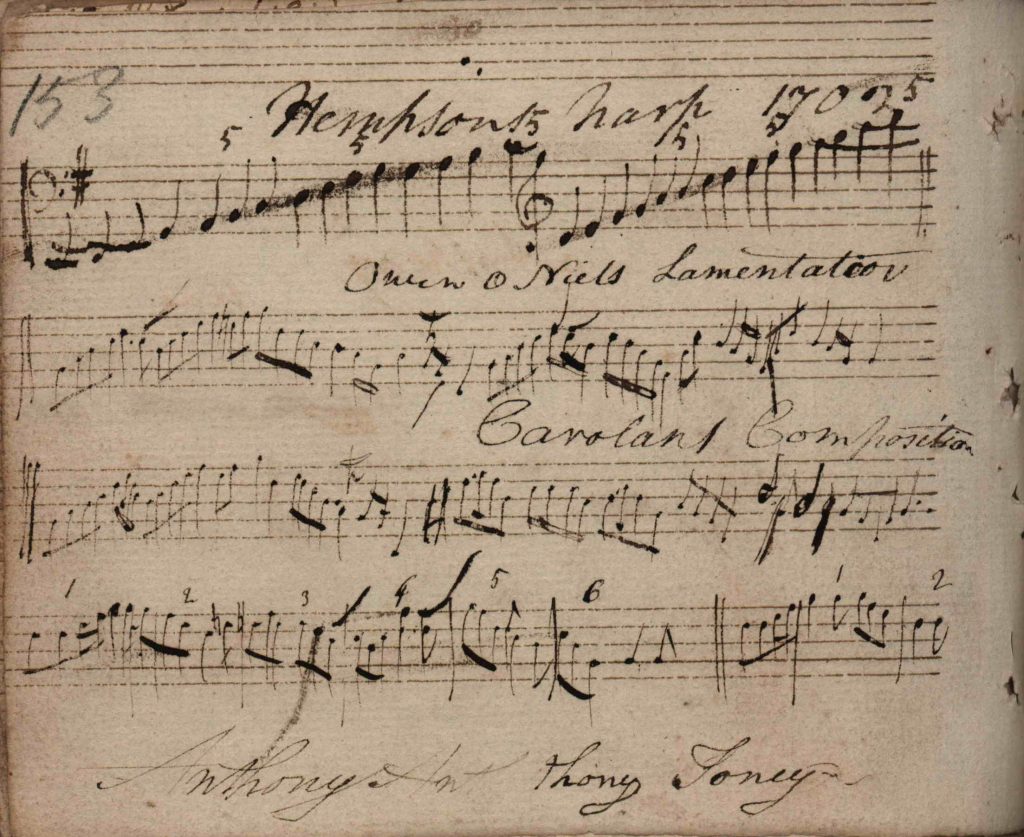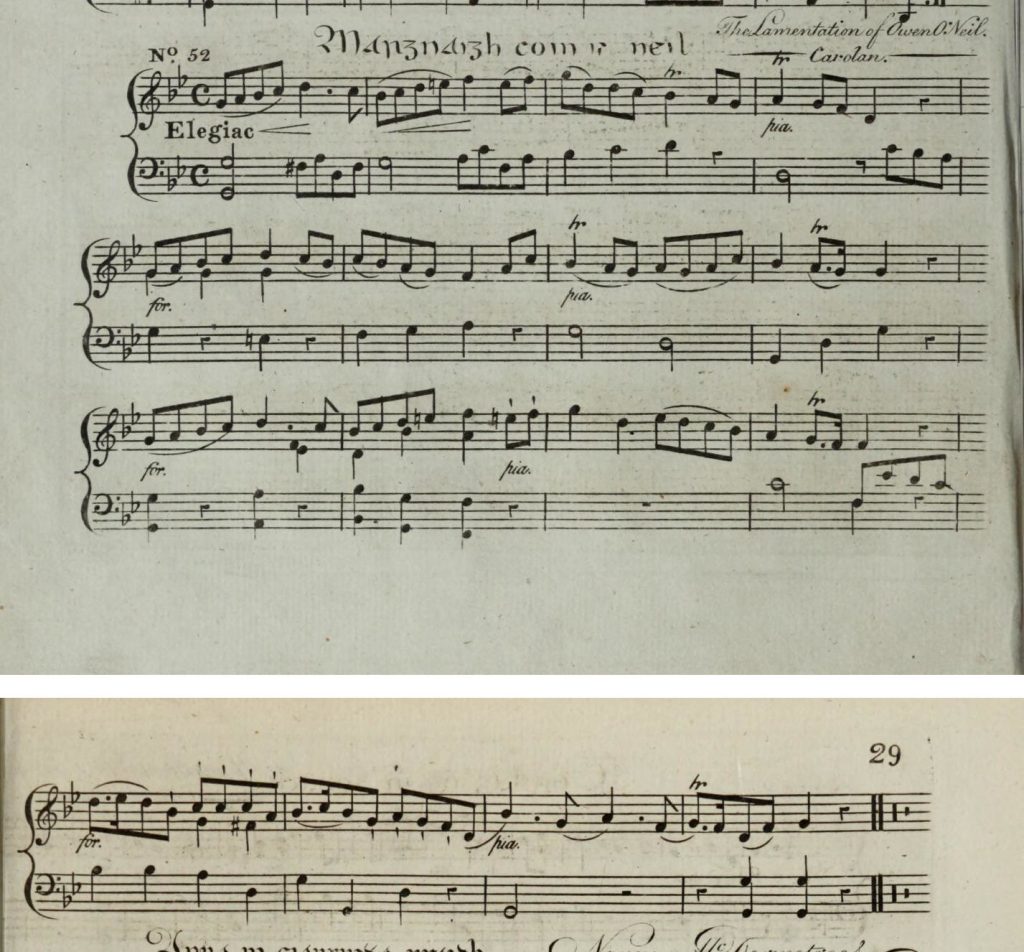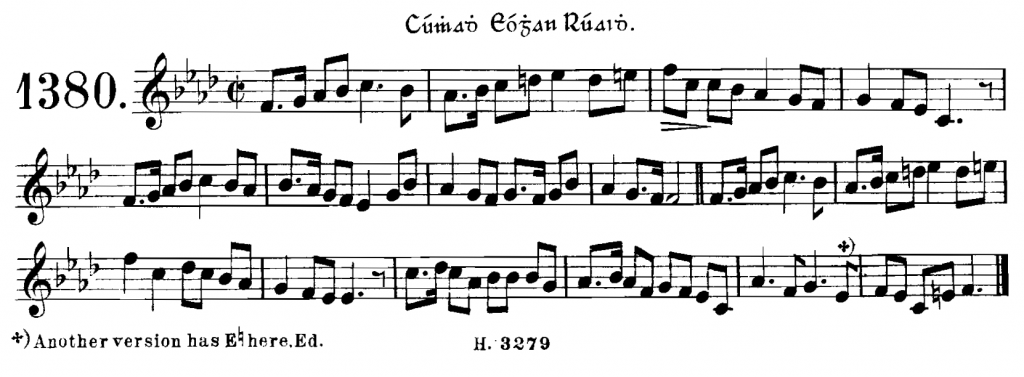As we have just been considering the upside-down leaf in QUB SC MS4.29 (p.199–200), we may as well deal with the other tune on page 199.
Underneath his live transcription notation of Maidin bhog aoibhinn, Bunting has written the next tune and its title, “Oyn O Neils Lamentation”.

I say “the next tune” but actually it looks like it is written in a different style, and was probably written at a different time in a different session.
The tune is clearly in A, and I think it is probably A neutral. The big question is how to understand the F♯ accidental which Bunting has written onto the 16th note in. At this stage I am not really sure how to understand this in a transcription notation.
Bunting’s other live transcription version?
Bunting has written another version of our tune in QUB SC MS4.29 p.153, but this is even harder to understand. I think it is a live transcription from a performance by a tradition-bearer informant.
If we check my MS4.29 index PDF, we can see that pages 152-155 seem to be a folded pair, and its edges don’t match the pages before and after. Page 152, containing My Lodging’s Uncertain, is “dirty” as if it once was the outside of a loose pamphlet. Page 155 has a neat copy of the tuning sequence copied from p.150, implying that this was done after our pages were incorporated into a larger grouping (perhaps p.150-157? The gathering here is very unclear). Our tune is on page 153, beneath the notes of “Hempson’s harp 1702” which is apparently a diagram counting and labelling the notes to which the 30 strings of the Downhill harp were tuned to. This diagram seems to be the source for the printed scale in the 1840 introduction page 23. But nothing else in this grouping of 4 or 8 pages seems connected to Denis O’Hampsey so I don’t really understand this.
Underneath our tune on p.153 is another tune, perhaps titled “Eloo wera”, which we can recognise as the spinning song “Is Iombó Eiriú” which you can hear reconstructed and sung by Páidrigín Ní Uallacháin. It has bar numbers written above it and it continues onto the facing page 154. There is also a lot of doodling on these two pages as well; there is an amazing psychadelic grid pattern on p.154, and the title of our p.153 tune “Owen O Neiels Lam”, and then writing: (p.153) “Anthony Ant thony Toney” (p.154) “Minuette Anthony / Anthony Bunting Anthony / Sam / Anthony / Anthony Master / Anthony / Ansale / Anthony M Master / Master”. If you understand this please let me know in the comments below.
Anyway let’s look at our notation. Bunting has written a title above the tune, “Owen O Niels Lamentation”, and he has tagged it “Carolans Composition” in the middle of the notation.

I am saying this is a live transcription notation, but it has some features that are more usually found in tunes copied out of books or manuscripts. It has a natural sign on the twelfth note, E, which kind of matches the accidental in the p.199 version. It is one note lower than the p.199 notation, and seems to be in G neutral.
We also have big minims towards the end. However it does look like it started as a line of live transcription dots, some of which have been deleted, and the rest filled out (using a rather scratchy pen) with stems and beams.
If I thought this might be a harp transcription I would consider it to have been notated one note higher than it would be played. But I think it may be more likely to be a vocal transcription, and so pitch level for a singer becomes much more arbitrary.
Bunting’s piano developments of this tune
Bunting published his piano arrangement in his 1797 book as no.52. You can see that his title there is “Margnaigh coin ui neil / The Lamentation of Owen O’Neil / Carolan”. I think we have to understand his Irish title as basically containing illiterate typos, the engraver completely mis-reading the handwriting of whoever provided Bunting with Irish titles, and putting “g” instead of “ḃ”, and putting “c” instead of “e”.

Instead of a machine audio, I thought you could listen to Fiachra Ó Corragáin playing Bunting’s classical piano arrangement instead.
I think it is clear that Bunting has based his piano interpretation on the transcription written on the “Hempson Harp 1702” page, MS4.29 p.153, and not on our upside-down p.199 one.
I am also interested to see the little bass runs in bars 4 and 12 of the piano arrangement. I used to wonder if this kind of bass melody fragment, when the treble is resting, was a characteristic sign of harp idiom in the piano arrangements. But we can clearly see here that there is no trace of these notes in the live transcription, and so I think we have to understand these kind of bass notes as being Bunting’s piano invention with no implication for understanding old Irish harp style or idiom.
Attribution to tradition-bearer informants
As usual in my Old Irish Harp Transcriptions project, I want to try and work out what the live transcription notations represent. I am assuming these scratchy dots were written by Edward Bunting live at speed while a tradition-bearer informant performed for him.
We have two of these pages which look to me like live transcriptions, which we looked at above: QUB MS4.29 pages 199 (upside-down) and 153 (Hempson Harp 1702). I am thinking that neither of these looks like it was transcribed from harp performance, and so the most likely seems to be that both are transcribed from vocal performances.
We can look for later retrospective metadata by checking derived piano arrangements to see if there is attribution information on them. In this case, the published piano arrangement (1797 no.52) seems to be the only derived work, and as noted above I think it is derived from the p.153 transcription notation.
We have a copy of the printed book which was annotated much later, I think in the early 1840s; at that late stage, over 40 years later, Bunting went through and added attribution information. (see Karen Loomis’s article on this). Against our tune, Bunting has written “Deil Castle”. Now this confuses me a little, since from my analysis of Bunting’s collecting trips, we can see that he went to Deel Castle in Summer 1792 with Kirwan, and my impression has been that the vocal transcriptions he made on that trip are in parts 2 and 4 of QUB SC MS4.29 (see my post on the structure of the manuscript). I think I have two or three possible thoughs about this – did Bunting take this folded pair (pages 152-155) on his trip with Kirwan? If so then why is it a different paper-type, with regular staves rather than the 2+2 layout we expect from parts 2 and 4? Or, did Bunting make a third live transcription on 2+2 paper that is now lost? Or, is the Deel Castle attribution (like others retrospectively added to piano arrangements in the late 1830s and early 1840s) completely spurious?
We can check my Old Irish Harp Transcription Project Tune List Spreadsheet to see if there are any patterns. I note that other items on pages 152-5 seem to be vocal, and one other has a “Castlebar” tag in later piano derivations, so perhaps this was a sheet from touring West and collecting from singers. Presumably the Hempson harp scale was added into an empty space, or perhaps it was first, and the song airs fitted later around it. Either way it looks in a very different ink and style.
I’m also not seeing much to help us with the upside down p.199 group. There are only three tunes on that group, and this one doesn’t seem to match the other two that well in the way it is written, as if it were done at a different time. I noted on my post on Maidin bhog aoibhinn that this sheet may have originally been the other way up at the end of part 1 of the manuscript, next to page 109; but the tunes there also seem a bit mixed and not well attributed.
In conclusion then, I don’t know who the tradition-bearer informant was for either of these two notations. I’m guessing they were two different singers in two different places but really I haven’t a clue.
Other versions of the tune
We should briefly look at other independent versions of the tune as well.
Stanford-Petrie has a version, no.1380 titled “Cúmhadh Eóghan Rúaidh”. I wonder if this is simply derived from Bunting’s 1797 published piano arrangement.

Donal O’Sullivan in his Carolan (no.211) prints a rather classical version from the manuscript of the collector, composer (and faker) Henry Hudson. For more on Hudson’s manuscripts, see Colette Moloney and Deirdre McDonald, ‘The Irish music manuscripts of Henry Hudson’, in Irish Musical Studies 12 (2019) p.134-143.
Donal O’Sullivan also references “Owen O’Neill’s March” in Joyce, no773 on p378. Being a march, is of course a very different tune, but I suppose it is actually of interest in being associated with the same person.
The piper James Cody wrote a version of our tune into his presentation note book that he gave to Edward Bunting c.1805-1809. His title is “Marana óghain ui néill”.

My machine audio ignores the “repeat sign” at the end of the second system; Cody seems to use this sign :||: in the same way we would use a simple double barline || to indicate the end of a section.
I think Cody’s version is especially interesting because Cody also wrote down a set of lyrics into QUB SC MS4.6.054-055, which begin “Iongna mhór sé is dóith liom féin”. This full text is published in Donal O’Sullivan, Bunting part 3, 1930, p.18-19. I haven’t found another tune version in MS4.6 so I assume that these words written by Cody go with the melody above in his presentation notebook. (Donal O’Sullivan in his usual wayward way ignores Cody’s melody and tries to force Cody’s words onto Bunting’s MS4.29 p.153 tune).
Attributions to Carolan as composer
Everyone seems to agree that Carolan composed an elegy to Owen O’Neil. It seems reasonable to think the tune might also be Carolan’s as well as the lyrics, though it can be hard to tell with some attributions. Donal O’Sullivan cites Hardiman p.lxii who says “Some of his elegiac productions are well known … In addition to these we have his “Cumhadh” or Lamentation for Owen Roe O Neill the celebrated Irish general…”
However, in the annotated 1797 printed book, someone has written a little cartouche around where the printed text says “Carolan”, and inserted above that and within the cartouche, “not by”. This looks to me to be a different writing from the attribution annotations. Has Bunting changed his mind between 1797 and the early 1840s?
Do we believe Bunting had new information by a tradition bearer? Or was he just sounding off his own opinion? Every one else seems sure that the lyrics and words are by Carolan. Do we believe anything that Bunting says?
Many thanks to Queen’s University Belfast Special Collections for the digitised pages from MS4 (the Bunting Collection), and for letting me use them here.
Many thanks to the Arts Council of Northern Ireland for helping to provide the equipment used for these posts, and also for supporting the writing of these blog posts.


Thank you for your concise analysis, Simon, as always. I always look forward to your blog posts, they are so very cool.
Jeannie and my prayers are for you and your valuable, from here just south of Denver, Colorado.
Thanks Bill, glad you find it interesting and useful.